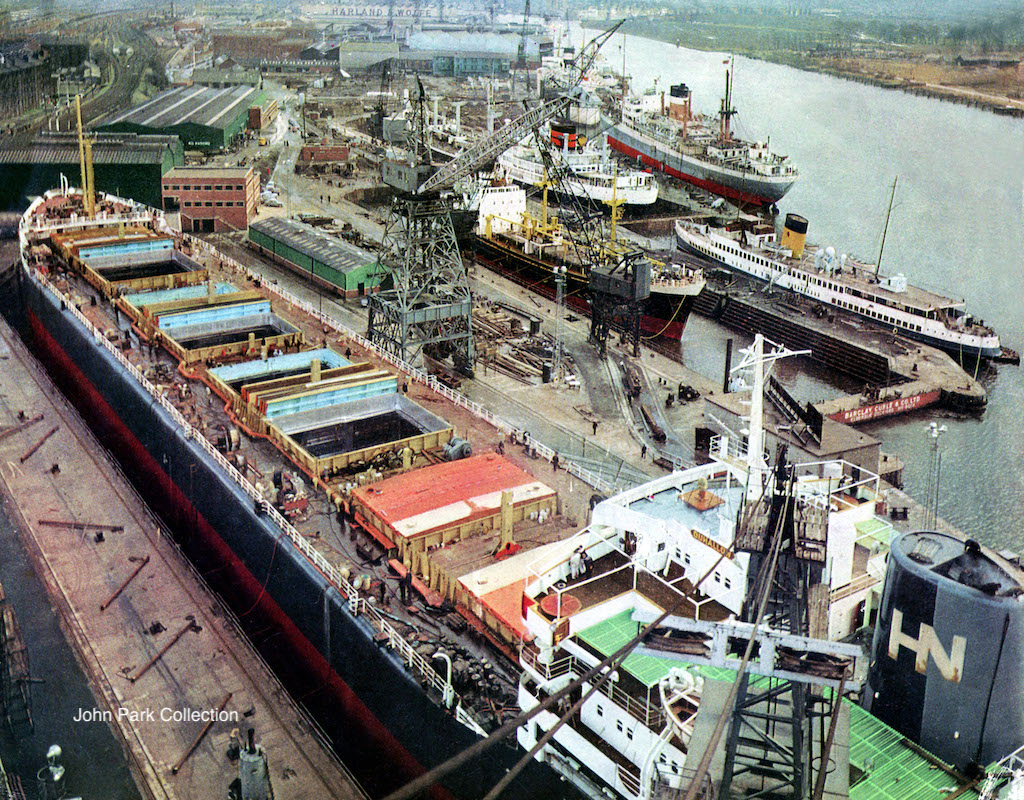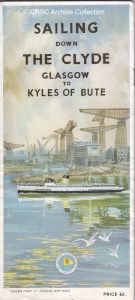
Queen Mary II undergoing annual overhaul in the late 1960s at Barclay, Curle & Co on the north bank of the River Clyde
A 1960s photograph in John Park’s collection has reminded him of how vibrant Clydeside used to be, and of the unusual company Clyde steamers sometimes kept out-of-season.
This ‘mystery’ view of Queen Mary II at Scotstoun (above right) has long been one of my favourite photos, as it is so full of interesting things. The original print was given to me in the 1970s, and the size and type of paper suggest it has come from a book. I have never seen it reproduced anywhere, so I have no idea of the publisher or who the photographer was.
Queen Mary II is in blue hull with full-length masts. This dates the photo to sometime between the spring of 1965, when most of the CSP fleet received blue hulls and funnel lions, and her pre-season overhaul in 1969, when the masts of the four remaining Clyde steamers — Caledonia, Duchess of Hamilton, Queen Mary II and Waverley — were brutally truncated to enable them to pass beneath the new Kingston Bridge, something which, in the end, they were never required to do.

This brochure for ‘doon the watter’ sailings by Queen Mary II was published by the CSP in the early 1960s and distributed on board by the ship’s assistant pursers
The ‘Mary’ has no wooden seats on deck and the rear staircase shelter is still boarded up from winter lay up. But what of the other ships?
Nearest the camera is Duhallow, launched by Fairfields in October 1965 and completed in March 1966 for the Hain Nourse (HN) company. She is very clean looking for a bulker, which makes me wonder if she is in new condition and perhaps undergoing final touches before entering service. That would certainly coincide with Queen Mary II being at Barclay Curle for annual overhaul around April. I cannot identify the ship next to her in the flooded dock.
Ahead of the ‘Mary’ in dry dock is a Clan Line ship, almost certainly one of the attractive Clan F or Clan G class of the early 1960s. There were seven of these identical ships in total, with five Clan Fs built on the Tyne and two Clan Gs on the Clyde. The Clyde-built ships came from the Greenock Dockyard Company in 1962 and had Sulzer engines supplied by Barclay Curle. It is quite possibly one of the Clyde-built pair in dry dock, which would be either Clan Graham or Clan Grant.
Outside the Clan Line ship, berthed on the river, is an Ellerman Lines ‘City of’ vessel. My knowledge of this fleet is limited so I cannot identify exactly which it is.
Also berthed on the river, ahead of the Ellerman Lines vessel, is a white-hulled ship with a black and white funnel. This probably belongs to the British India Steam Navigation Company, as they were regular customers of Barclay Curle. However, the vessel is too obscured by the forest of shipyard cranes to identify conclusively.
Other interesting sights on dry land include what I presume to be Garscadden station in the distant top left, an island platform surrounded by lots of long-since removed freight lines.
Top centre is the huge Harland & Wolff engineering shed, which by the time of this photograph would have been manufacturing turbine machinery for the power station industry rather than marine applications.
To the right of that, on the other side of the river, is shipping berthed in the King George V dock at Shieldhall. The industrial-looking site on the south bank nearer to the camera belonged to Braehead Power Station (1946-82): that whole area from there to the KGV dock is now part of what we know as Braehead retail park.
All this in a single photograph!
All photographs on the CRSC website are subject to copyright law. Do not reproduce them on Facebook, Pinterest or any other public platform.

A photo of Queen Mary II from 1970, showing the truncated mainmast dating from 1969 and the lion which was affixed to the side of the funnel in 1965. This modern-looking single funnel replaced the vessel’s two slim original funnels and was fitted during re-boilering at the Barclay Curle yard at Scotstoun in the winter of 1956-57. The debate continues as to whether she best suited one or two funnels
PREVIOUS POSTS BY JOHN PARK:
Battling a southerly swell in Millport Bay
King George V’s last public cruise
The KGV Charters (Members Only)
Published on 3 September 2020











